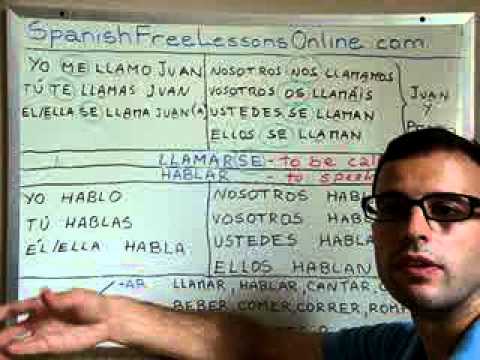Spanish verbs that end in AR (1st category of Spanish verbs)
All Spanish verbs are divided in three groups
- Spanish verbs that end in AR
- Spanish verbs that end in ER
- Spanish verbs that end in IR
The first category would be the largest group, and the third category would be the smallest.
In this lesson we’ll learn the rule to conjugate the first group of regular verbs in the Present tense. For this purpose lets conjugate the following Spanish verbs that are regular and that end in AR.
- HABLAR – to speak / to talk
- LLAMAR – to call
- LLAMARSE – to be called (reflexive form of the Spanish verb LLAMAR)
- CANTAR – to sing
- COCINAR – to cook
Verbo HABLAR en PRESENTE SIMPLE (Simple Present)
Yo hablo – I read
Tú hablas – you read (informal)
Usted habla – you read (formal)
Él/ella habla – he/she reads
Nosotros hablamos – we read
Vosotros habláis – you read (plural – this is the form used in Spain)
Ustedes hablan – you read (plural – this is the form used in Latin-America)
Ellos hablan – They read
Verbo LLAMAR en PRESENTE SIMPLE (Simple Present)
Yo llamo
Tú llamas
Usted llama
Él/ella llama
Nosotros llamamos
Vosotros llamáis
Ustedes llaman
Ellos llaman
Verbo LLAMARSE en PRESENTE SIMPLE (Simple Present)
Yo me llamo
Tú te llamas
Usted se llama
Él/ella se llama
Nosotros nos llamamos
Vosotros os llamáis
Ustedes se llaman
Ellos se llaman
Verbo CANTAR en PRESENTE SIMPLE (Simple Present)
Yo canto
Tú cantas
Usted canta
Él/ella canta
Nosotros cantamos
Vosotros cantáis
Ustedes cantan
Ellos cantan
Verbo COCINAR en PRESENTE SIMPLE (Simple Present)
Yo cocino
Tú cocinas
Usted cocina
Él/ella cocina
Nosotros cocinamos
Vosotros cocináis
Ustedes cocinan
Ellos cocinan
As you can see, the root of the root of the verbs are unbold, and the endings are all in bold letters.
In Spanish it is extremely common to turn most verbs into its reflexive form, same as I just showed you with the Spanish verb LLAMAR and LLAMARSE.
For example, we could turn the Spanish verb COCINAR (to cook) into it’s reflexive form COCINARSE and now we can use it to say (to cook for oneself). For example: Yo me cocino arroz (I cook for myself some rice). Therefore, it is very important to understand how to use reflexive forms of Spanish verbs.
Look how the pattern is the same regardless of the verb. The root verb that we are conjugating (without the ER ending) plus the ending, which is the same for every verb (depending on who the subject is). So, you need to learn the correct endings and you will be able to conjugate all the regular verbs.
You can find a full list of all the video lessons by clicking on the List of Lessons tab on the Main Menu.
Although we will be focussing more on vocabulary and grammar, pay attention to the Spanish pronunciation in these video lessons, and remember to practice repeating the same words and sounds.
To enlarge the video-screen to full-screen mode, click on the right icon on the lower right corner of the video.













In the video, you said that Juan means John, and Juan can be Juan or Juana, but then what does Juana mean? Johna?